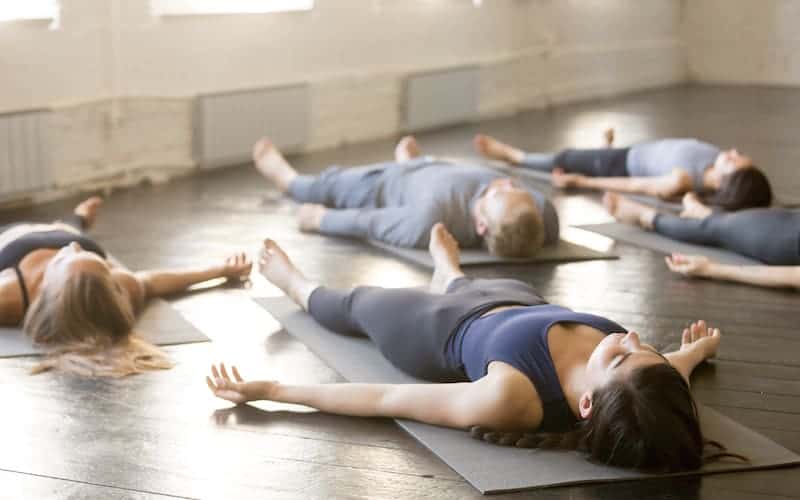Yoga Nidra training is one of the best practices for newcomers to meditation and yoga. Developed in the 1940s by Swami Satyananda Saraswati in Rishikesh, India, Yoga Nidra (translated as “yogic sleep”) is the practice of conscious relaxation.
The practitioner’s inner awareness remains alert, but the body, mind, and psyche are calmed through a guided sequence that includes setting an intention, systematically relaxing the body, using visualization to relax the mind, and evoking positive emotions in the unconscious mind to open it to greater receptivity. Restful and liberating, Yoga Nidra training is an ideal practice for those of us who feel pushed to our limits or stuck in an undesirable place in our lives.
The Process
A variety of CDs and books are available to guide you through Yoga Nidra teacher training. Physically, all that is demanded of the practitioner is that they remain still and comfortable in Savasana (corpse pose) for about 30 minutes and remain awake and aware (i.e. don’t drift off into sleep.) The rest of the journey is created by your guide, which may be a recorded voice or a live person if you are attending a yoga Nidra training session at a studio or retreat. There is an endless variety of visualizations created for Yoga Nidra training that include beautiful imagery and metaphors. As you learn about the practice of Yoga Nidra teacher training, you may even begin to create your own visualizations.
There are Eight Essential Steps in the Process:
- Preparation: The practitioner finds a restful position in Savasana. Props, pillows, blankets and eye bags can be used to ensure comfort. It is very important that the body remain completely still during the meditation.
- Resolve: Before entering the complete state of relaxation, the practitioner is invited to set an intention or resolve. This may be anything from feeling rested to improving health or breaking a bad habit. This practice is based on the theory that an open and relaxed subconscious is instantly receptive to thought. It is essential that this resolve or intention is be stated positively and in present tense as the subconscious fixates on negative language and cannot hear the overall message. For example, “I will not lie,” is not as effective a message for the brain as “I am truthful.” Likewise, “I am rested,” is more effective than “I will not be tired.”
- Rotation of Consciousness: By guiding the mental awareness through a specific sequence throughout the body, the practitioner simultaneously relaxes the anatomical parts of the body and the associated neuropathways.
- Awareness of the Breath: Once the body is relaxed, awareness centers on the breath, the prime energy mover in our beings.
- Feelings and Sensations: Permission is given to the emotional self to let go of negative thoughts such as judgment, anxiety, and fear.
- Visualization: Here, the mind embarks on a journey of imagery and storytelling, usually with a definite goal, which relaxes mental activity.
- Ending the Practice: The final image of a Yoga Nidra typically creates a sense of joy, peacefulness, or calmness within the practitioner, making the subconscious self receptive to our intentions, which are restated in the mind at this time.
- Awakening: Awareness is brought back to the outer layers of the self gently by deepening the breath to awaken the mind and gently stretching to enliven the body.
Theory

Sleep is only restful for our sensate beings, our conscious minds, and our bodies. Sleep does not rejuvenate our inner selves, the subconscious and psychic, or spiritual, aspects of our beings; these are left to wander wild in the process of sleep, which our awareness interprets as dreaming. In Yoga Nidra training, we remain alert in a kind of “psychic sleep,” guiding our beings to a state of genuine relaxation that can take us to a higher level of self-realization.
Benefits may include the following:
- Increased energy, feeling of restfulness
- Alleviation of addiction (over time)
- Alleviation of symptoms of some psychosomatic illnesses and chronic pain
- Improved memory and imagination
- Easing of mental and physical tensions
- Development of willpower
- Improved overall sense of wellbeing
Prepare a Yoga Nidra Script for Guided Relaxation
Yoga Nidra is efficient for inducing a relaxation response in the body: physically, mentally and emotionally. During this conscious deep sleep state, the eyes are closed; the senses are withdrawn and the focus is on the body and breath. One is alert and aware. All the worries, tensions and stresses of everyday life melt away as the practitioner is progressively guided into the yoga sleep.
Guidance for Speaking or Recording a Yoga Nidra Script
A Yoga Nidra script can be spoken by a yoga teacher who can guide the student through the relaxation. A yoga teacher is then in a position to help the person through the phases of the relaxation, to gently prompt them if they start to fall asleep and bring them back to full consciousness.
The script may also be self-recorded and played back, using a personal recording device. The advantage is that this recording can then be accessed at a most convenient time and location. This may also encourage more self reliance on learning to relax deeply and discipline to not fall asleep. Add some calming music to the start and end of the recording.
What is more important than the wording of the script is the pace and tone. Allow space between words and sentences. Pause between and repeat key words and phrases such as “relax the body” and “breathe in and out.” Ensuring a steady and slow rhythm will facilitate a deeper relaxation. Speak not too loudly nor too softly.
Yoga Teacher Guides the Practitioner Through Yoga Nidra

Provide a calm, quiet and appropriate environment for the Yoga Nidra. Some people like to dedicate a room or corner in their home for their relaxation practices. Having props such as mat, blanket and eye pillow close at hand will ease the Yoga Nidra set up. Yoga nidra can be done sitting up or lying down.
Instruct the practitioner to concentrate on the voice of the speaker, and to pay attention to their mind and breath; if the mind wanders, do not worry. Guide them to take a deep breath in, feeling calmness and warmth spreading through the body; as they breathe out, allow them to feel their worries and stress melting away.
Guide them through creating a sankalpa, which is an intention based on the heart’s desire. Request them to think of a statement in the present tense such as “I am relaxed, happy and at peace.” Ask them to state their own sankalpa three times, in their mind, as though it is already happening. Continue to guide them through the yoga nidra with a body scan. Remind them to breathe completely, softly and deeply.
Towards the end of the Yoga Nidra, gently bring them back to the present using full body awareness. Remind them of the sankalpa, ask them to repeat their intention again in their mind. Encourage them to notice how they feel, mentally, emotionally, physically. Slowly bring them back to the present, fully awake and refreshed. Proceed with gentle body movements.
Deep Relaxation Can Be More Effective when Guided
For many people, it helps to have guidance during relaxation. This is particularly important during Yoga Nidra teacher training as it aims to promote self awareness and not simply to drift off to sleep. A trained yoga teacher leading the practitioner can allow a deeper surrender into the yogic sleep. By concentrating on the spoken word, the practitioner is free to enjoy the relaxation completely.









